概率统计c 2_3
高三数学选修2-3(B版)_专题提升:概率与统计
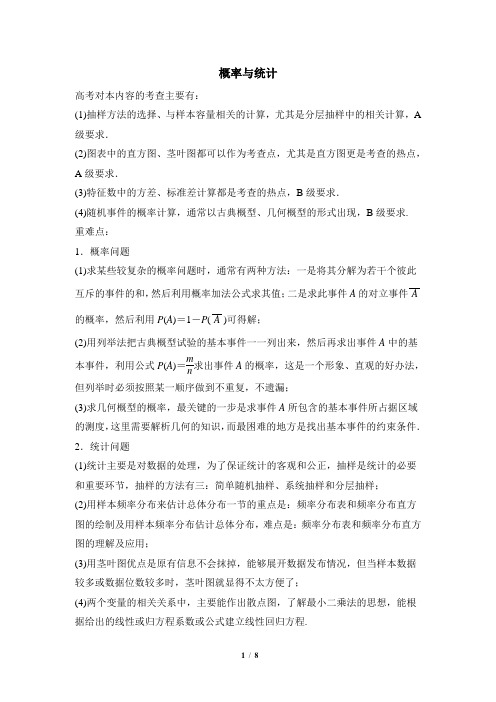
概率与统计高考对本内容的考查主要有:(1)抽样方法的选择、与样本容量相关的计算,尤其是分层抽样中的相关计算,A 级要求.(2)图表中的直方图、茎叶图都可以作为考查点,尤其是直方图更是考查的热点,A级要求.(3)特征数中的方差、标准差计算都是考查的热点,B级要求.(4)随机事件的概率计算,通常以古典概型、几何概型的形式出现,B级要求.重难点:1.概率问题(1)求某些较复杂的概率问题时,通常有两种方法:一是将其分解为若干个彼此互斥的事件的和,然后利用概率加法公式求其值;二是求此事件A的对立事件A 的概率,然后利用P(A)=1-P(A)可得解;(2)用列举法把古典概型试验的基本事件一一列出来,然后再求出事件A中的基本事件,利用公式P(A)=mn求出事件A的概率,这是一个形象、直观的好办法,但列举时必须按照某一顺序做到不重复,不遗漏;(3)求几何概型的概率,最关键的一步是求事件A所包含的基本事件所占据区域的测度,这里需要解析几何的知识,而最困难的地方是找出基本事件的约束条件.2.统计问题(1)统计主要是对数据的处理,为了保证统计的客观和公正,抽样是统计的必要和重要环节,抽样的方法有三:简单随机抽样、系统抽样和分层抽样;(2)用样本频率分布来估计总体分布一节的重点是:频率分布表和频率分布直方图的绘制及用样本频率分布估计总体分布,难点是:频率分布表和频率分布直方图的理解及应用;(3)用茎叶图优点是原有信息不会抹掉,能够展开数据发布情况,但当样本数据较多或数据位数较多时,茎叶图就显得不太方便了;(4)两个变量的相关关系中,主要能作出散点图,了解最小二乘法的思想,能根据给出的线性或归方程系数或公式建立线性回归方程.考点1、抽样方法【例1】某学院的A,B,C三个专业共有1 200名学生,为了调查这些学生勤工俭学的情况,拟采用分层抽样的方法抽取一个容量为120的样本. 已知该学院的A专业有380名学生,B专业有420名学生,则在该学院的C专业应抽取________名学生.【方法技巧】分层抽样适用于总体由差异明显的几部分组成的情况,按各部分在总体中所占的比实施抽样,据“每层样本数量与每层个体数量的比与所有样本数量与总体容量的比相等”列式计算;在实际中这种有差异的抽样比其他两类抽样要多的多,所以分层抽样有较大的应用空间,应引起我们的高度重视.【变式探究】某校高三年级学生年龄分布在17岁、18岁、19岁的人数分别为500、400、200,现通过分层抽样从上述学生中抽取一个样本容量为m的样本,已知每位学生被抽到的概率都为0.2,则m=________.【解析】(500+400+200)×0.2=220.【答案】220考点2、用样本估计总体【例2】(2013·重庆卷改编)以下茎叶图记录了甲、乙两组各五名学生在一次英语听力测试中的成绩(单位:分)已知甲组数据的中位数为15,乙组数据的平均数为16.8,则x,y的值分别为________.【解析】由茎叶图及已知得x=5,又因9+15+10+y+18+245=16.8,所以y=8.【答案】5,8【方法技巧】由于数据过大,直接计算会引起计算错误,故要学会像解析中介绍的两种方法那样尽量简化计算;同时要理解茎叶图的特点,能够从茎叶图获取原始数据.【变式探究】某校共有400名学生参加了一次数学竞赛,竞赛成绩的频率分布直方图如图所示(成绩分组为[0,10),[10,20),…,[80,90),[90,100]).则在本次竞赛中,得分不低于80分以上的人数为______ .【例3】袋中有红、黄、白3种颜色的球各1只,从中每次任取1只,有放回地抽取3次,求:(1)3只全是红球的概率;(2)3只颜色全相同的概率;(3)3只颜色不全相同的概率.解(1)记“3只全是红球”为事件A.从袋中有放回地抽取3次,每次取1只,共会出现3×3×3=27种等可能的结果,其中3只全是红球的结果只有一种,故事件A的概率为P(A)=1 27.(2)“3只颜色全相同”只可能是这样三种情况:“3只全是红球”(事件A);“3只全是黄球”(设为事件B);“3只全是白球”(设为事件C).故“3只颜色全相同”这个事件为A+B+C,由于事件A、B、C不可能同时发生,因此它们是互斥事件.再由红、黄、白球个数一样,故不难得P(B)=P(C)=P(A)=127,所以P(A+B+C)=P(A)+P(B)+P(C)=1 9.(3) 3只颜色不全相同的情况较多,如是两只球同色而另一只球不同色,可以两只同红色或同黄色或同白色等等;或三只球颜色全不相同等.考虑起来比较麻烦,现在记“3只颜色不全相同”为事件D,则事件D为“3只颜色全相同”,显然事件D与D是对立事件.∴P(D)=1-P(D)=1-19=89.【方法技巧】在求某些稍复杂的事件的概率时,通常有两种方法:一是将所求事件的概率化成一些彼此互斥事件的概率的和;二是先去求此事件的对立事件的概率.一个复杂事件若正面情况比较多,反面情况较少,则一般利用对立事件进行求解;对于“至少”,“至多”等问题往往用这种方法求解.【训练3】(2013·陕西卷改编)如图,在矩形区域ABCD的A,C两点处各有一个通信基站,假设其信号的覆盖范围分别是扇形区域ADE和扇形区域CBF(该矩形区域内无其他信号来源,基站工作正常).若在该矩形区域内随机地选一地点,则该地点无信号的概率是________.考点预测:1.某校从高一年级学生中随机抽取部分学生,将他们的模块测试成绩分成6组:[40,50),[50,60),[60,70),[70,80),[80,90),[90,100]加以统计,得到如图所示的频率分布直方图.已知高一年级共有学生600名,据此估计,该模块测试成绩不少于60分的学生人数为________.2.先后两次抛掷一枚骰子,在得到点数之和不大于6的条件下,先后出现的点数中有3的概率为________.3.某单位有职工160名,其中业务人员120名,管理人员16名,后勤人员24名.为了解职工的某种情况,要从中抽取一个容量为20的样本.若用分层抽样的方法,抽取的业务人员、管理人员、后勤人员的人数应分别为________.【解析】分层抽样应按各层所占的比例从总体中抽取.4.有3个兴趣小组,甲、乙两位同学各自参加其中一个小组,每位同学参加各个小组的可能性相同,则这两位同学参加同一个兴趣小组的概率为________.5.一个袋中有3个黑球,2个白球共5个大小相同的球,每次摸出一球,放进袋里再摸第二次,则两次摸出的球都是白球的概率为________.6.从甲、乙、丙等5名候选学生中选2名作为青年志愿者,则甲、乙、丙中有2个被选中的概率为________.7.为了分析某篮球运动员在比赛中发挥的稳定程度,统计了该运动员在6场比赛中的得分,用茎叶图表示如图所示,则该组数据的方差为________.【解析】平均数x =14+17+18+18+20+216=18,故方差s 2=16[(-4)2+(-1)2+02+02+22+32)]=5.【答案】58.袋中装有大小相同且形状一样的四个球,四个球上分别标有“2”、“3”、“4”、“6”这四个数.现从中随机选取三个球,则所选的三个球上的数恰好能构成一个等差数列的概率是________.【解析】总的取法是4组,能构成等差数列的有{2,3,4},{2,4,6} 2组;故所求概率为P =24=12.【答案】129.设f (x )=x 2-2x -3(x ∈R ),则在区间[-π,π]上随机取一个数x ,使f (x )<0的概率为________.10.从长度分别为2,3,4,5的四条线段中任意取出三条,则以这三条线段为边可以构成三角形的概率是________.11.利用计算机产生0~1之间的均匀随机数a ,则事件“3a -1>0”发生的概率为________.12.从一副没有大小王的52张扑克牌中随机抽取1张,事件A 为“抽得红桃8”,事件B 为“抽得为黑桃”,则事件“A +B ”的概率值是________(结果用最简分数表示).13.在集合A ={2,3}中随机取一个元素m ,在集合B ={1,2,3}中随机取一个元素n ,得到点P (m ,n ),则点P 在圆x 2+y 2=9内部的概率为________.【解析】由题意得到的P (m ,n )有:(2,1),(2,2),(2,3),(3,1),(3,2),(3,3)共计6个;在圆x 2+y 2=9的内部的点有(2,1),(2,2),所以概率为26=13.【答案】13 14.抛掷甲、乙两枚质地均匀且四面上分别标有1,2,3,4的正四面体,其底面落于桌面,记所得的数字分别为x ,y ,则x y 为整数的概率是________.。
概率论 2概率的统计定义、古典概型

个。
• 例8 从1~100的一百个整数中任取一数,试求取到的整数能被 6或8整除的概率。
几何概率( Geometric Probability)
将古典概率中的有限性推广到无限性,而保留等可
能性,就得到几何概率。
特点
有一个可度量的几何图形S 试验E看成在S中随机地投掷一点
事件A就是所投掷的点落在S中的可度量图形A中
投掷两颗骰子,试计算两颗骰子的点数之 和在4和10之间的概率. 解:设A表示点数之和在4和10之间
1 2 5 P( A) 1 2 2 36 36 6
求
P A B, P A B, P A B
设 P A 0.4,
P AB P A B P A AB 0.2
A B 0.4 0.7 0.2 0.9
0.4 0.3 0.2 0.5
古典概率 (Classical Probability)
考察如下几个试验:
抛两枚均匀的硬币,观察它们出现的正反面的情况。 掷骰子一颗,观察其点数。 掷一颗骰子并抛一枚硬币,观察骰子的点数和硬币的 正反面情况。
(2) 事件A,B有包含关系
解 (1) 由于 AB , 因此 A B A, B A B P( A B) P( A) 0.3 P( B A) P( B) 0.6
(2) 由已知条件和性质3,推得必定有
A B
P( A B) P() 0
P( B A) P( B) P( A) 0.3
它们都具备如下特点: (1)每次试验中,所有可能的结果只有有限多个。 (2)每次试验中,每一种可能的结果发生的可能性相同。 满足这些条件的数学模型称作古典概率。
(最全)高中数学概率统计知识点总结
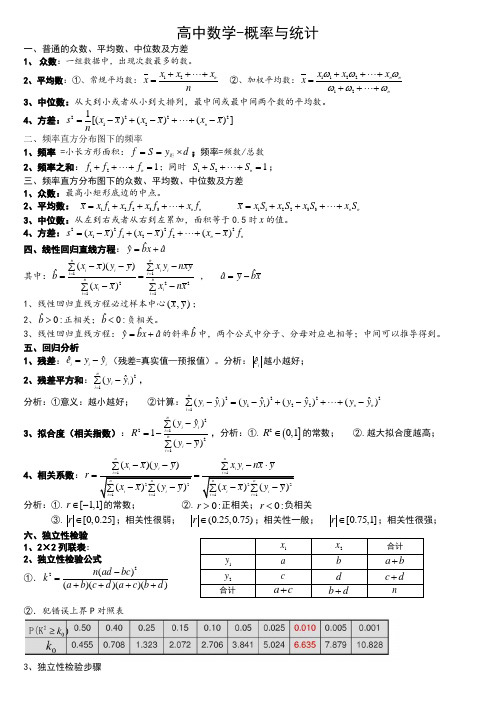
高中数学-概率与统计一、普通的众数、平均数、中位数及方差 1、 众数:一组数据中,出现次数最多的数。
2、平均数:①、常规平均数:12nx x x x n++⋅⋅⋅+=②、加权平均数:112212n n n x x x x ωωωωωω++⋅⋅⋅+=++⋅⋅⋅+3、中位数:从大到小或者从小到大排列,最中间或最中间两个数的平均数。
4、方差:2222121[()()()]n s x x x x x x n=-+-+⋅⋅⋅+- 二、频率直方分布图下的频率1、频率 =小长方形面积:f S y d ==⨯距;频率=频数/总数2、频率之和:121n f f f ++⋅⋅⋅+=;同时 121n S S S ++⋅⋅⋅+=;三、频率直方分布图下的众数、平均数、中位数及方差 1、众数:最高小矩形底边的中点。
2、平均数: 112233n nx x f x f x f x f =+++⋅⋅⋅+ 112233n n x x S x S x S x S =+++⋅⋅⋅+ 3、中位数:从左到右或者从右到左累加,面积等于0.5时x 的值。
4、方差:22221122()()()n n s x x f x x f x x f =-+-+⋅⋅⋅+-四、线性回归直线方程:ˆˆˆybx a =+ 其中:1122211()()ˆ()nni i i i i i nni i i i x x y y x y nxybx x x nx ====---∑∑==--∑∑ , ˆˆay bx =- 1、线性回归直线方程必过样本中心(,)x y ;2、ˆ0:b>正相关;ˆ0:b <负相关。
3、线性回归直线方程:ˆˆˆy bx a =+的斜率ˆb 中,两个公式中分子、分母对应也相等;中间可以推导得到。
五、回归分析1、残差:ˆˆi i i ey y =-(残差=真实值—预报值)。
分析:ˆi e 越小越好; 2、残差平方和:21ˆ()ni i i y y=-∑, 分析:①意义:越小越好; ②计算:222211221ˆˆˆˆ()()()()ni i n n i y yy y y y y y =-=-+-+⋅⋅⋅+-∑ 3、拟合度(相关指数):22121ˆ()1()ni i i ni i y yR y y ==-∑=--∑,分析:①.(]20,1R ∈的常数; ②.越大拟合度越高;4、相关系数:()()nni i i i x x y y x y nx yr ---⋅∑∑==分析:①.[r ∈-的常数; ②.0:r >正相关;0:r <负相关③.[0,0.25]r ∈;相关性很弱; (0.25,0.75)r ∈;相关性一般; [0.75,1]r ∈;相关性很强; 六、独立性检验 1、2×2列联表: 2、独立性检验公式 ①.22()()()()()n ad bc k a b c d a c b d -=++++②.犯错误上界P 对照表3、独立性检验步骤①.计算观察值k :2()()()()()n ad bc k a b c d a c b d -=++++;②.查找临界值0k :由犯错误概率P ,根据上表查找临界值0k ;③.下结论:0k k ≥:即犯错误概率不超过P 的前提下认为: ,有1-P 以上的把握认为: ; 0k k <:即犯错误概率超过P 的前提认为: ,没有1-P 以上的把握认为: ;【经典例题】题型1 与茎叶图的应用例1(2014全国)某市为考核甲、乙两部门的工作情况,学科网随机访问了50位市民。
概率统计公式大全
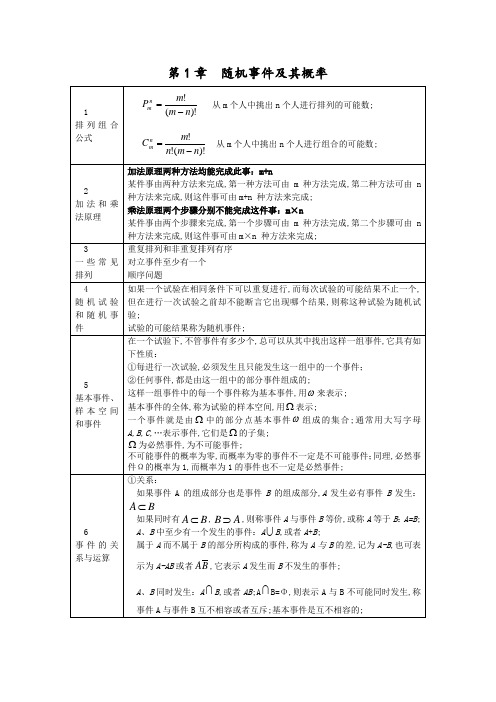
2Fx,y分别对x和y是非减的,即
当x2>x1时,有Fx2,y≥Fx1,y;当y2>y1时,有Fx,y2≥Fx,y1;
3Fx,y分别对x和y是右连续的,即
4
5对于
.
4
离散型与连续型的关系
5
边缘分布密度
离散型
X的边缘分布为
;
Y的边缘分布为
;
连续型
X的边缘分布密度为
Y的边缘分布密度为
6
条件分布
离散型
在已知X=xi的条件下,Y取值的条件分布为
均匀分布
设随机变量 的值只落在a,b内,其密度函数 在a,b上为常数 ,即
a≤x≤b
其他,
则称随机变量 在a,b上服从均匀分布,记为X~Ua,b;
分布函数为
a≤x≤b
0,x<a,
1,x>b;
当a≤x1<x2≤b时,X落在区间 内的概率为
;
指数分布
,
0, ,
其中 ,则称随机变量X服从参数为 的指数分布;
我们称随机变量F服从第一个自由度为n1,第二个自由度为n2的F分布,记为F~fn1, n2.
第四章 随机变量的数字特征
1
一维随机变量的数字特征
离散型
连续型
期望
期望就是平均值
设X是离散型随机变量,其分布律为P =pk,k=1,2,…,n,
要求绝对收敛
设X是连续型随机变量,其概率密度为fx,
要求绝对收敛
对于连续型随机变量, ;
5
八大分布
0-1分布
即B1,p
PX=1=p, PX=0=q
二项分布
即Bn,p
在 重贝努里试验中,设事件 发生的概率为 ;事件 发生的次数是随机变量,设为 ,则 可能取值为 ;
工程数学_概率统计简明教程_第二章_随机事件
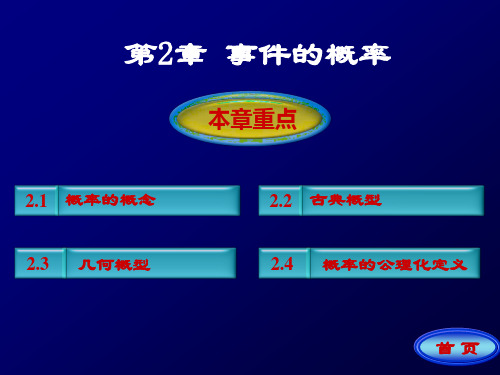
成一件事情有n 个步骤,第 i 个
步骤中有 mi 种具体的方法,则完成这件事情 n 共有 m
i 1
i
种不同的方法
选排列 从 n 个不同的元素中,任取 m 个
(不放回地)按一定次序排成一列,不同的 排法共有
Pnm n(n 1)( n 2) (n m 1)
等可能性
每次试验中,每一种可能结果发生的可能性相同, 即
1 P( A1 ) P( A2 ) P( An ) n Ai i , i 1,2,, n 其中
古典概型的计算公式
确定试验的基本事件总数
设试验结果共有n个,即基本事件ω1,ω2,..., ωn ,而且这些事件的发生具有相同的可能性
例
已知P(A)=0.3, P(B)=0.6,试在下列两
种情形下分别求出P(A-B)与P(B-A)
(1) 事件A,B互不相容 (2) 事件A,B有包含关系
解
(1) 由于 AB ,因此 A B A, B A B
P( A B) P( A) 0.3 P( B A) P( B) 0.6
次试验,事件A发 生的频率 m/n,随着试验次
数n的增大而稳定地在某个常数 p附近摆动,那么
称p为事件A的概率
P( A) p
当试验次数足够大时,可以用事件A发生的频 率近似的代替事件A的概率
排列组合有关知识复习
加法原理:完成一件事情有n 类方法,第 i 类
方法中有 mi 种具体的方法,则完成这件事情 n 共有 m
当人数为 50 时, {生日“无重复”} 的概率为:0.03
古典概率的计算:抽签
10个学生抽签的方式分配3张音乐会入场券,抽取 10张外观相同的纸签,其中3张代表入场券.求 A={第 五个学生抽到入场券}的概率。
2023考研概率统计全考点精讲-第二讲 随机变量及其分布

第二讲 随机变量及其分布【考试要求】1.理解随机变量的概念,理解分布函数(){}()F x P X x x =≤−∞<<+∞的概念及性质,会计算与随机变量相联系的事件的概率.2.理解离散型随机变量及其概率分布的概念,掌握0-1分布、二项分布(,)B n p 、几何分布、超几何分布、泊松(Poisson)分布()P λ及其应用.3.(数一了解,数三掌握)泊松定理的结论和应用条件,会用泊松分布近似表示二项分布.4.理解连续型随机变量及其概率密度的概念,掌握均匀分布(,)U a b 、正态分布2(,)N μσ、指数分布及其应用,其中参数为λ的指数分布()λE 的概率密度为()e ,00,0x x f x x λλ−⎧>=⎨≤⎩.5.会求随机变量函数的分布.考点:随机变量与分布函数1.随机变量:设试验E 的样本空间为Ω,如果对于每一个样本点Ω∈ω,都有一个实数)(ωX 与之对应,则称定义在Ω上的单值实值函数)(ωX 为随机变量,简记为X . 通常用,,X Y Z 等表示随机变量.【注】随机变量的等式和不等式可表示随机事件. 2.分布函数(1)定义:设X 是一个随机变量,x 是任意实数,称(){}()F x P X x x =≤−∞<<+∞为X 的分布函数.(2)基本性质①单调不减,即若12x x <,则12()()F x F x ≤;②lim ()0x F x →−∞=,lim ()1x F x →+∞=; ③()F x 是右连续,即(0)()F x F x +=.【注】这三条性质是一个函数作为某随机变量的分布函数的充分必要条件. (3)其他性质(用分布函数()F x 求概率)①)()(}{a F b F b X a P −=≤<; ②)0(}{−=<a F a X P ;③)0()(}{−−==a F a F a X P ;④)0()0(}{−−−=<≤a F b F b X a P ; ⑤)()0(}{a F b F b X a P −−=<<; ⑥{}()(0)P a X b F b F a ≤≤=−−. 【注】分布函数在处连续.【例1】 下述函数中,可以作为某个随机变量的分布函数的是( ) (A ) ()211F x x =+ (B )()x x F sin = (C ) ()11arctan π2F x x =+ (D ) ()1e ,020,0xx F x x −⎧−>⎪=⎨⎪≤⎩【例2】 设随机变量X 的分布函数为()00πsin 02π12,x F x A x,x ,x ⎧⎪<⎪⎪=≤≤⎨⎪⎪>⎪⎩,则A _____=,6P X ______π⎧⎫<=⎨⎬⎩⎭.【例3】 已知随机变量X 的分布函数为()0,11,18,111,1x x F x ax b x x <−⎧⎪⎪=−⎪=⎨⎪+−<<⎪≥⎪⎩,且()F x a {}0P X a ⇔=={}114P X ==,则_____,_____a b ==. 【例4】 设随机变量X 的分布函数为⎪⎩⎪⎨⎧≥−<≤<=−1,110,210,0)(x e x x x F x,则{}1P X ==( )(A )0 (B )21(C )121−−e (D )11e −−考点:离散型随机变量及其分布1.离散型随机变量定义:若随机变量X 所有可能取值是有限或可列无限个,则称X 为离散型随机变量.2.分布律(1)定义:设离散型随机变量X 的所有可能取值为()12i x i ,,=,且X 取ix 的概率为i p ,则称{}()12i i P X x p i ,,===为离散型随机变量X 的分布律.X(2)基本性质:①0,1,2,i p i ≥=;②11ii p∞==∑.【注】这两条性质也是一个数列可以作为某随机变量分布律的充分必要条件. 3.离散型随机变量的分布函数若离散型随机变量X 的分布律为{}()12i i P X x p i ,,===,则X 的分布函数为(){}{}()i i i i x xx xF x P X x P X x p x ≤≤=≤===−∞<<+∞∑∑.若123x x x <<<,则()111212230,,,x x p x x x F x p p x x x <⎧⎪≤<⎪=⎨+≤<⎪⎪⎩. 【注】若已知X 的分布函数()F x (阶梯函数),则X 的分布律为{}()()0i i i P X x F x F x ==−−,12i ,,=.【例1】 (1)做n 次伯努利实验,已知每次成功的概率均为()10<<p p ,令X 表示n 次试验中成功的次数,求X 的分布律.(2)做伯努利试验,已知每次成功的概率均为()10<<p p ,令X 表示直到第一次成功为止所进行的实验次数,求X 的分布律.【例2】 设袋中有5个球,其中3个新球,2个旧球,从中任取3个球,用X 表示3个球中新球个数,求X 的分布律与分布函数.考点:连续型随机变量及其分布1.连续型随机变量及其概率密度(1)定义:设随机变量X 的分布函数为()F x ,若存在非负可积函数()f x ,使得对于任意实数x ,有()()xF x f t dt −∞=⎰,则称X 为连续型随机变量,()f x 称为X 的概率密度函数,简称概率密度(简写为.f .d .p ).【注】①只有存在概率密度的随机变量才能称为连续型随机变量,分布函数连续的随机变量不一定是连续型随机变量.②存在既非连续型又非离散型的随机变量.③(),()()0()F x x F x f x x F x '⎧=⎨⎩为的可导点,为的不可导点. (2)概率密度的基本性质:①()0f x ≥;②()1f x dx +∞−∞=⎰.【注】这两条性质是一个函数可以作为概率密度函数的充分必要条件.(3)连续型随机变量的其他性质: ①)(x F 处处连续.②对()+∞∞−∈∀,a ,有{}.0==a X P ③若()f x 在x 处连续,则有()()F x f x '=. ④对于任意的实数()1212x ,x x x ≤,有{}()()211221()x x P x X x F x F x f x dx <≤=−=⎰.【例1】 设随机变量X 的概率密度为()x f ,则下列函数中必为某随机变量的概率密度的是( )(A )()x f 2 (B )()x f 2 (C )()x f −1 (D )()x f −1【例2】 设随机变量X 的概率密度为()cos ,||20,||2A x x f x x ππ⎧≤⎪⎪=⎨⎪>⎪⎩,求(1)常数A ; (2)X 的分布函数为()x F . 【例3】 设随机变量X 的概率密度为()1||,||10,x x f x else −<⎧=⎨⎩,则______412=⎭⎬⎫⎩⎨⎧<<−X P .考点:常见分布1.常见的离散型随机变量 (1) 0-1分布若随机变量X 的分布律为{}()()110101kk P X k p p ,k ,p −==−=<<,则称X 服从0-1分布,记为),1(~p B X .(2) 二项分布若随机变量的分布律为{}C (1),0,1,2,k k n kn P X k p p k n −==−=,其中01p <<,则称X 服从二项分布,记为~(,)X B n p .(3) 几何分布若随机变量X 的分布律为{}1(1)k P X k p p −==−⋅,1,2,3k =,其中01p <<,则称X 服从参数为p 的几何分布,记为()~X G p .(4) 超几何分布(从未考过)若随机变量X 的分布律为{}C C C k n kM N MnNP X k −−==,其中N k ∈,且{}{}n M k N n M ,min ,0max ≤≤−+,则称X 服从超几何分布.【注】:此公式的数学模型为:设N 件产品中含M 件次品,现从中任取n 件产品,则所取的n 件产品恰有k 件次品的概率.(5) 泊松分布 ①定义若随机变量X 的分布律为{}e !kP X k k λλ−==,0,1,2,k =,其中0λ>,则称X 服从参数为λ的泊松分布,记为~()X P λ.X②泊松定理(数一了解;数三掌握)设0λ>是一个常数,n 是任意正整数,若lim n n np λ→∞=,则对于任意的非负整数k ,有()e lim 1.!nk n kkknn n C p p k λλ−−→∞−=【例1】 设随机变量X 服从参数为()2,p 的二项分布,随机变量Y 服从参数为()3,p 的二项分布,若{}519P X ≥=,则{}1_______P Y ≥=. 【例2】 设某时间段内通过一路口的汽车流量服从泊松分布,已知该时段内没有汽车通过的概率为1e,则这段时间内至少有两辆汽车通过的概率为___________. 2.常见的连续型随机变量 (1) 均匀分布若X 的概率密度为1,()0,a xb f x b a⎧<<⎪=−⎨⎪⎩其它,则称X 在()a,b 上服从均匀分布,记为()~,X U a b ,其分布函数为0,(),1,x a x aF x a x b b a x b<⎧⎪−⎪=≤<⎨−⎪⎪≥⎩. (2) 指数分布若X 的概率密度为e ,0()0,0x x f x x λλ−⎧>=⎨≤⎩,其中0λ>,则称X 服从参数为λ的指数分布,记为()XE λ,其分布函数为1e ,0()0,0x x F x x λ−⎧−≥=⎨<⎩.(3) 正态分布若随机变量X的概率密度为22()2()()x f x x μσ−−=−∞<<+∞,其中0σ>,μ与σ均为常数,则称X 服从参数为,μσ的正态分布,记为2~(,)X N μσ,其分布函数为22()2()d ()t xF x t x μσ−−=−∞<<+∞⎰.特别地,当0,1μσ==,即~(0,1)X N ,称X 服从标准正态分布,其概率密度为22(),x x x ϕ−=−∞<<+∞,分布函数22()d t xx t −Φ=⎰,x −∞<<+∞.【注】(1)指数分布的无记忆性:若()~X E λ,则对任意的0,0s t >>,有{}{}|.P X s t X s P X t >+>=>【例3】 设随机变量()6,1~U X ,则方程012=++Xy y 有实根的概率为____.【例4】 设随机变量()~2,5X U ,现对X 进行三次独立重复观测,求至少有两次观测值大于3的概率.【例5】 设随机变量Y 服从参数为12λ=的指数分布,求关于未知量x 的方程2230x Yx Y ++−=没有实根的概率.【例6】 设随机变量的概率密度函数为()221e ()x x f x k x −+−=−∞<<+∞X则常数=_______k .【例7】 设随机变量()22,X N σ且{}240.3P X <<=,则{}0_______P X <=.【例8】 设随机变量()2,X N μσ,则概率{}P X μσ−<的值随着σ的增大而( )(A )增大 (B )减小 (C )保持不变 (D )无法确定考点:随机变量函数的分布1.离散型随机变量函数的分布设X 为离散型随机变量,其概率分布为{},1,2,i i P X x p i ===,函数()g x 连续,则随机变量()Y g X =的分布律为{}(),1,2,i k k i g x y P Y y p k ====∑.做法:找到Y 全部可能的取值,算出相应值的概率.【例1】 设随机变量X 在()1,2−上服从均匀分布,1,01,0X Y X −<⎧=⎨≥⎩,求Y 的分布律.【例2】(课后作业)设随机变量X 的概率分布为,求常数和的概率分布. 2.连续型随机变量函数的分布情形一:Y 为离散型. 做法:找到Y 全部可能的取值,算出相应值的概率. 情形二:Y 为连续型.(1)分布函数法(代数法和几何法)先求出()Y g X =的分布函数()Y F y ,即()(){}()()Y g x y F y P g X y f x dx ≤=≤=⎰,再对()YF y 求导得到Y 的概率密度()Y f y .(2)公式法 若()y g x =在X 的取值区间内有连续导数()g x ',且()0g x '>或者()0g x '<,则()Y g X =是连续型随机变量,且其概率密度为{}(1,2,)3k c P X k k ===c sin()2Y X π=()()()',0,X Y f h y h y y f y αβ⎧<<⎡⎤⎪⎣⎦=⎨⎪⎩其他其中(),αβ为()y g x =的值域,()h y 是()g x 的反函数.情形三:Y 既非连续型又非离散型 做法:分布函数法求其分布函数.【例3】 设随机变量X 服从()0,2上的均匀分布,则随机变量2Y X =在()0,4内的概率密度()Y f y _______=.【例4】 设随机变量X 的概率密度为()22,00,x x f x ππ⎧<<⎪=⎨⎪⎩其它,求sin Y X =的概率密度()Y f y .。
概率c怎么计算 相关公式是什么

概率c怎么计算相关公式是什么概率c的计算公式概率公式c的计算方法:一般地,C(n,k)=n(n-1)(n-2)。
(n-k+1)/k!,其中k≤n,例如,C(12,3)=12×11×10/3!=1320/(3×2×1)=1320/6=220;概率公式C和A的区分:“A”是排列方法的数量,跟挨次有关:例如:n个不同的物体,要取出m个(m=n)进行排列,方法就是A(n,m)种。
也可以这样想,排列放第一个有n种选择,其次个有n-1种选择,第三个有n-2种选择,……,第m个有n+1-m种选择,所以总共的排列方法是n(n-1)(n-2)……(n+1-m),也等于A(n,m)。
“C”是组合方法的数量,跟挨次无关:比如:C(3,2)表示从3个物体中选出2个,总共的方法是3种,分别是甲乙、甲丙、乙丙(3个物体是不相同的状况下)。
概率和频率的区分一、指代不同1、频率:在相同的条件下,进行了n次试验,在这n次试验中,大事A发生的次数m称为大事A发生的频数。
2、概率:反映随机大事消失的可能性大小。
随机大事是指在相同条件下,可能消失也可能不消失的大事。
二、计算方法不同1、频率:当重复试验的次数n渐渐增大时,频率fn(A)呈现出稳定性,渐渐稳定于某个常数,这个常数就是大事A 的概率,这种“频率稳定性”也就是通常所说的统计规律性。
2、概率:重复做n次试验,nA为n次试验中大事A发生的次数,假如随着n渐渐增大,频率nA/n渐渐稳定在某一数值p四周,则数值p称为大事A在该条件下发生的概率,记做P(A)=p。
三、用处不同1、频率:随机大事A发生的概率p(A)是该大事消失的可能性大小的度量。
其数值在0与1之间。
在肯定条件下进行试验,假如大事A不行能发生,则p(A)=0;假如大事A必定发生,则p(A)=1。
随着试验次数n的增大,频率接近于概率的可能性也越大2、概率:某一大事A(也是S中的某一区域),S包含A,它的量度大小为μ(A),若以P(A)表示大事A发生的概率,考虑到“匀称分布”性,大事A发生的概率取为:P(A)=μ(A)/μ(S)。
概率统计2-3

1−p o p 1
p x
9
例题与解答
例2 甲乙两名射手在一次射击中得分(分别用 ξ,η表示)的分布律如下表所示, 试比较甲,乙两 射手的技术.
ξ
P
8
9
10
η
P
8
9
10
0.3 0.1 0.6
0.2 0.5 0.3
解 Eξ=8×0.3+9×0.1+10×0.6=9.3 Eη=8×0.2+9×0.5+10×0.3=9.1 这表明, 如多次射击, 他们得分的平均值分 别是9.3和9.1, 故甲射手较乙射手的技术好。
+ ∫ ( 55 − x )dx + ∫ ( 65 − x )dx ]
25 55
55
60
E(Y)=E(g(X))=
∫
+∞
−∞
g( x ) f ( x )dx
1 = ( 12.5 + 200 + 450 + 37.5 ) 60 =11.67(分)
21
例题与解答
*例8.假定世界市场对我国某种出口商品的需求量 X(吨)是个随机变量,它服从区间[2000,4000]上的均 匀分布,设该商品每出售一吨,可获利3万美元外汇, 但若销售不出去而压库,则每吨支付保养费1万美元, 问如何计划年出口量,可使期望获利最多。 解:设计划年出口量为y吨,年创利Y万美元,显然 X≥y 3y y∈[2000,4000],且有 Y = g( X ) = 3X − ( y − X ) X < y +∞ 4000 1 EY = ∫ g( x) f ( x)dx = 2000 g ( x ) dx −∞ 由微积分可知: 由微积分可知: 2000 4000 y 1 y=3500时 = 2000 [ ∫ ( 4 x − y ) dx + ∫ 3 ydx 当y=3500时, 2000 y EY最大 EY最大。 最大。 2
概率统计 第二章 随机变量及其分布
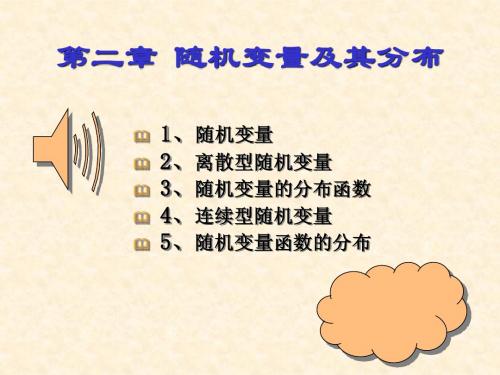
引入适当的随机变量描述下列事件: 例1:引入适当的随机变量描述下列事件: 个球随机地放入三个格子中, ①将3个球随机地放入三个格子中,事件 A={有 个空格} B={有 个空格} A={有1个空格},B={有2个空格}, C={全有球 全有球} C={全有球}。 进行5次试验, D={试验成功一次 试验成功一次} ②进行5次试验,事件 D={试验成功一次}, F={试验至少成功一次 试验至少成功一次} G={至多成功 至多成功3 F={试验至少成功一次},G={至多成功3次}
例2
xi ∈( a ,b )
∑
P( X = xi )
设随机变量X的分布律为 设随机变量X
0 1 2 3 4 5 6 0.1 0.15 0.2 0.3 0.12 0.1 0.03
试求: 试求:
P( X ≤ 4), P (2 ≤ X ≤ 5), P ( X ≠ 3)
0.72 0.7
F ( x) = P{ X ≤ x} =
k : xk ≤ x
∑p
k
离散型随机变量的分布函数是阶梯函数, 离散型随机变量的分布函数是阶梯函数 分布函数的跳跃点对应离散型随机变量的 可能取值点,跳跃高度对应随机变量取对应 可能取值点 跳跃高度对应随机变量取对应 值的概率;反之 反之,如果某随机变量的分布函数 值的概率 反之 如果某随机变量的分布函数 是阶梯函数,则该随机变量必为离散型 则该随机变量必为离散型. 是阶梯函数 则该随机变量必为离散型
X
x
易知,对任意实数a, 易知,对任意实数 b (a<b), P {a<X≤b}=P{X≤b}-P{X≤a}= F(b)-F(a) ≤ = ≤ - ≤ = -
P( X > a) = 1 − F (a)
概率论与数理统计课件3-2边际分布和条件分布

解
由上述分布律的表格可得
P{ X 1,Y 0} 0.030 , P{Y 0 X 1} 0.045 P{ X 1} P{ X 1,Y 1} 0.010 , P{Y 1 X 1} 0.045 P{ X 1} P{ X 1,Y 2} 0.005 , P{Y 2 X 1} 0.045 P{ X 1}
Y 的条件概率密度为 1 , 0 x y 1, fY X ( y x ) 1 x 0, 其它.
因此 X 和 Y 的联合概率密度为 f ( x , y ) fY X ( y x ) f X ( x )
1 , 0 x y 1, 1 x 0, 其它. 际 故得Y 的边缘概率密度
P { X xi , Y y j } P {Y y j }
pij p j
, i 1, 2,
为在给定Y y j 条件下 X 的条件分布列.
同理,对于一切使P{ X xi } pij pi 0的 xi , 则称
j 1
p j i P{Y y j X xi }
边际分布 联合分布 条件分布 联合分布
设( X , Y ) 在圆域 x 2 y 2 1 上服从均匀分布, 求条 例3 件概率密度 f X Y ( x y ).
解 由题意知随机变量( X ,Y ) 的概率密度为
1 π , x 2 y 2 1, f ( x, y) 0, 其它,
二
1.边际分布
边际分布和条件分布
问题:已知二维随机变量 (X, Y) 的分布, 如何求出 X 和 Y 各自的分布?
边际分布函数
已知 (X, Y) 的联合分布函数为 F(x, y),
概率论与数理统计2_3连续型随机变量
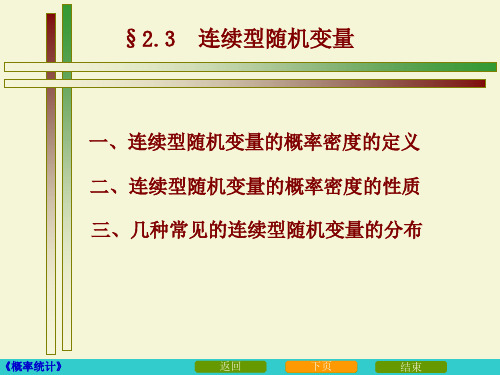
《概率统计》
返回
下页
结束
若不计高阶无穷小,有
f ( x)
f (a)1ຫໍສະໝຸດ oP{ x X x x } f ( x )x
的概率近似等于
a
x
它表示随机变量 X 取值于 ( x, x x ]
x)) x x ff ((x
在连续型随机变量理论中所起的作用与
P X xk pk
x2 , f ( x) A, 0, 0 x 1 1 x 2 其它
求 (1)常数A; ( 2) P{0 X 3};
(3)分布函数F(x).
2
解: (1)由于f(x)是一个密度函数,
由
f ( x)dx 1, 得
2 2 1
x dx
0
1
Adx 1
《概率统计》
返回
下页
结束
例3.设随机变量X在[2,8]上服从均匀分布,求二次方程 y2+2Xy+9=0 有实根的概率.
解:由于X服从均匀分布,故X的概率密度为
1 , 2 x8 f ( x) 6 0, 其它
方程有实根等价于4X236≥0 , 即X≥3或X≤3. 从而, P{y2+2Xy+9=0 有实根}=P{X≥3}+P{X≤3}
1 f ( x) e 2
( x )2 2 2
f(x)
, x
其中μ,σ(σ>0)为常数,则称X服从参 数为μ,σ2的正态分布或高斯(Gauss) 分布,记作 X~ N(μ,σ2)
0
x
分布函数
F(x)
x 1 e 2 ( t )2 2 2
F ( x)
概率与数理统计2-4

四. 超几何分布
1、定义 N 件产品中,有M件次品,不放回地 任取 n 件产品, 其中含有 次品的件数X的 概率分布为
P( X k ) C C
k M
nk N M
/ C , k 0,1, 2,..., r
n N
其中 M N , n N , r min{M , n} ,则称 X服从超几何分布。记为 X ~ H (n, N , M )
有放回抽样.
2 、 0 – 1 分布 (两点分布)
X P
1 0 p 1-p
k 1 k
0<p<1来自或P( X k ) p (1 p) , k 0, 1
注: 0–1 分布是 n = 1时 的二项分布, 即b(1, p) 应用 凡试验只有两个结果, 常用0 – 1 场合 分布描述, 如产品是否合格、人 口性别统计、系统是否正常、电力消耗 是否超标等等.
解 令X 表示5000次射击中的命中次数, 则 X ~ b( 5000, 0.001 ) 令 np 5 5 5 5 5 5 4995 P( X 5) C5000 (0.001) (0.999) e 5!
5 5 P( X 1) 1 P( X 0) 1 e 0.993. 0! 注: 此结果可直接查 P421 附表1 泊松 分布表得到,它与用二项分布算得的结果 仅相差万分之几.
• 0
x
设 X ~ b(10, 0.2)
0 1 2 3 4 5 6 7 8 9 10 .107 .268 .302 .201 .088 .027 .0.006 .001 < .001 P
0.302
由图表可见 , 当 k 2 时, 分布概率值最大
P 10 (2) 0.302
设在15只同类型零件中有2只为次品在其中取3次每次任取1只作不放回抽样以X表示取出的次品个数
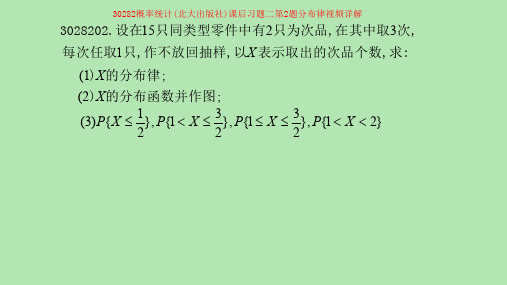
(2)X的分布函数并作图;
解(2) 当x 0时,F(x) P(X x) 0
当0 x 1时,F(x) P(X x) P(X 0) 22
当1
x
2时,F(x)
P(X
x)
P(X
0)
35 P(X
1)
34
当x 2时,F(x) P(X x) 1 0, x 0
35
故X的分布函数
F
(x)
22 35 34 35
, ,
0 x 1 1 x 2
1, x 2
30282概率统计(北大出版社)课后习题二第2题分布律视频详解
3028202.设在15只同类型零件中有2只为次品,在其中取3次,
每次任取1只,作不放回抽样,以X 表示取出的次品个数,求:
(3)P{X 1}, P{1 X 3}, P{1 X 3}, P{1 X 2}
12 . 35
P(X
2)
C113 C135
1. 35
故所求分布律为 X 0 1 2
p 22 12 1 35 35 35
30282概率统计(北大出版社)课后习题二第2题分布律视频详解
3028202.设在15只同类型零件中有2只为次品,在其中取3次,
每次任取1只,作不放回抽样,以X 表示取出的次品个数,求:
2
2
2
30282概率统计(北大出版社)课后习题二第2题分布律视频详解
3028202.设在15只同类型零件中有2只为次品,在其中取3次,
每次任取1只,作不放回抽样,以X 表示取出的次品个数,求:
(1)X的分布律;
解(1)
X
0,1, 2. P( X
0)
C133 C135
22 . 35
概率论与数理统计知识点总结(超详细版)
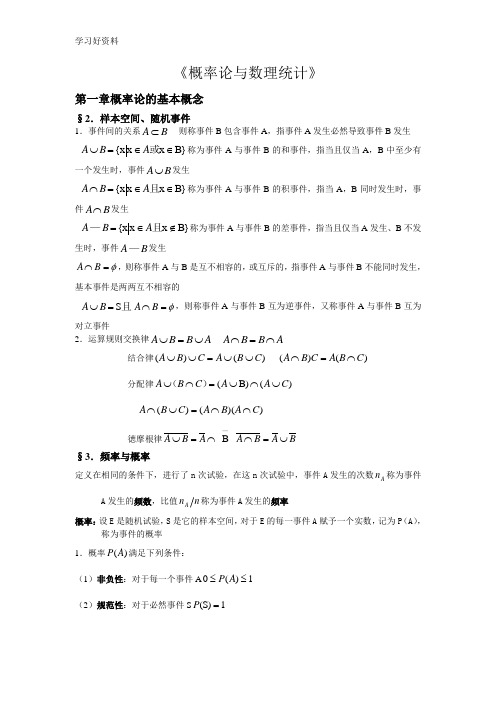
《概率论与数理统计》第一章概率论的基本概念§2.样本空间、随机事件1.事件间的关系 B A ⊂则称事件B 包含事件A ,指事件A 发生必然导致事件B 发生B }x x x { ∈∈=⋃或A B A 称为事件A 与事件B 的和事件,指当且仅当A ,B 中至少有一个发生时,事件B A ⋃发生B }x x x { ∈∈=⋂且A B A 称为事件A 与事件B 的积事件,指当A ,B 同时发生时,事件B A ⋂发生B }x x x { ∉∈=且—A B A 称为事件A 与事件B 的差事件,指当且仅当A 发生、B 不发生时,事件B A —发生φ=⋂B A ,则称事件A 与B 是互不相容的,或互斥的,指事件A 与事件B 不能同时发生,基本事件是两两互不相容的且S =⋃B A φ=⋂B A ,则称事件A 与事件B 互为逆事件,又称事件A 与事件B 互为对立事件2.运算规则交换律A B B A A B B A ⋂=⋂⋃=⋃结合律)()( )()(C B A C B A C B A C B A ⋂=⋂⋃⋃=⋃⋃ 分配律 )()B (C A A C B A ⋃⋂⋃=⋂⋃)())(()( C A B A C B A ⋂⋂=⋃⋂徳摩根律B A B A A B A ⋃=⋂⋂=⋃ B —§3.频率与概率定义在相同的条件下,进行了n 次试验,在这n 次试验中,事件A 发生的次数A n 称为事件A 发生的频数,比值n n A 称为事件A 发生的频率概率:设E 是随机试验,S 是它的样本空间,对于E 的每一事件A 赋予一个实数,记为P (A ),称为事件的概率 1.概率)(A P 满足下列条件:(1)非负性:对于每一个事件A 1)(0≤≤A P (2)规范性:对于必然事件S 1)S (=P(3)可列可加性:设n A A A ,,,21 是两两互不相容的事件,有∑===nk knk kA P A P 11)()( (n 可以取∞)2.概率的一些重要性质: (i ) 0)(=φP(ii )若n A A A ,,,21 是两两互不相容的事件,则有∑===nk kn k kA P A P 11)()((n 可以取∞)(iii )设A ,B 是两个事件若B A ⊂,则)()()(A P B P A B P -=-,)A ()B (P P ≥ (iv )对于任意事件A ,1)(≤A P (v ))(1)(A P A P -=(逆事件的概率)(vi )对于任意事件A ,B 有)()()()(AB P B P A P B A P -+=⋃§4等可能概型(古典概型)等可能概型:试验的样本空间只包含有限个元素,试验中每个事件发生的可能性相同 若事件A包含k个基本事件,即}{}{}{2]1k i i i e e e A =,里个不同的数,则有中某,是,,k k n 2,1i i i ,21 ()中基本事件的总数包含的基本事件数S }{)(1j A n k e P A P kj i ===∑= §5.条件概率(1) 定义:设A,B 是两个事件,且0)(>A P ,称)()()|(A P AB P A B P =为事件A 发生的条件下事件B 发生的条件概率(2) 条件概率符合概率定义中的三个条件1。
概率论与数理统计2-3

P ( x1 < X ≤ x2 ) = F ( x2 ) − F ( x1 ) = ∫ x 2 f ( x )dx 1
x
3) 对任意 P(X=x)=0. 从而对任意实数 b, (a<b), 对任意x, 从而对任意实数a, P (a ≤ X ≤ b) = P (a < X <与数理统计
第二章
随机变量及其概率分布
定理 : 设F ( x ), f ( x )分别为连续随机变量 X的分布函数 和密度函数 .若f ( x )在点x处连续 , 那么 f ( x ) = F ' ( x ). 由该定理和注8可知 可知,若 注9 由该定理和注 可知 若F(x)除至多可数个点外有连续 除至多可数个点外有连续 导数, 导数 那么密度函数 F ' ( x ) 在F ( x )有连续导数处 f ( x) = 任意取值 其他 由注9给出的密度函数可能会有一定差异 给出的密度函数可能会有一定差异,但不影响 注10 由注 给出的密度函数可能会有一定差异 但不影响 分布函数的表示和事件概率的计算. 分布函数的表示和事件概率的计算 这种现象是概率论研 究中的一种特色, 而称这样的密度函数是几乎处处相等的, 究中的一种特色 而称这样的密度函数是几乎处处相等的 对其简单说明如下: 设有随机变量X及函数 及函数g(x),h(x),若 对其简单说明如下 设有随机变量 及函数 若 P ( X ∈ { x : g( x ) = h( x )}) = 1, 几乎处处相等. 称g(x),h(x)几乎处处相等 几乎处处相等
华东师范大学统计系
概率论与数理统计
第二章
随机变量及其概率分布
3 几个常用的连续型分布 1) 均匀分布 设连续型随机变量X具有密度函数 设连续型随机变量 具有密度函数 1 b− a − 1 b− a , a ≤ x ≤ b, f ( x) = 其他 , 0, a b 则称X在区间 在区间[a, 上服从均匀分布 上服从均匀分布. 则称 在区间 b]上服从均匀分布 记作X ~ U (a , b ) F ( x) 分布函数为: 分布函数为: 0 , 1 x < a,
概率统计实验指导书2,3
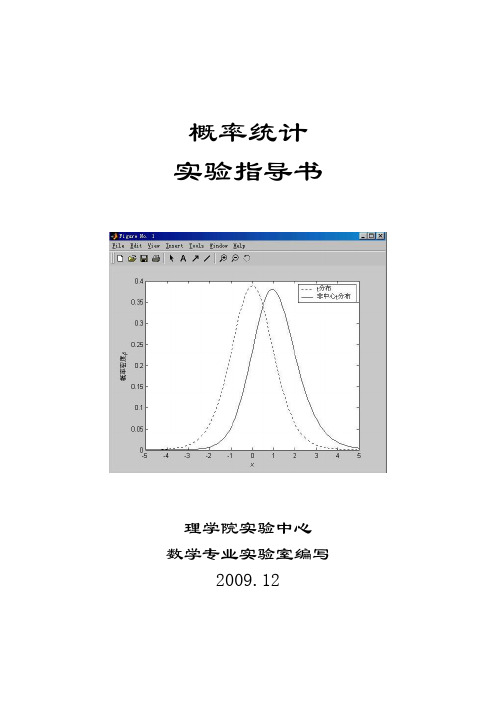
概率统计实验指导书理学院实验中心数学专业实验室编写2009.12实验二 统计分析1 引1. 问题:湖中有鱼,其数不知。
现在请你想一个办法,能将湖中的鱼数大致估计出来。
2. 分析:有两种方法。
[方法一] 设湖中有N 条鱼。
先捕出r 条鱼,做上记号后放回湖中(设记号不会消失)。
让湖中的鱼充分混合后,再从湖中捕出s 条鱼,设其中有T 条鱼标有记号,则T 是随机变量,且服从超几何分布{}(0)t s tr N rsNC C P T t t r C --==≤≤。
应用极大似然估计思想,寻找N,使{}P T t =达到最大,得sr N t ⎡⎤=⎢⎥⎣⎦。
于是取sr N t ⎡⎤=⎢⎥⎣⎦作为湖中鱼数的一种估计,其中[]x 表示不超过x 的最大整数。
[方法二] 用矩估计法.因为T 服从超几何分布,其数学期望是()srE T N=,此即捕s 条鱼得到有标记的鱼的总体平均数。
而现在只捕一次,出现t 条有标记的鱼。
由矩估计法,令总体一阶原点矩等于样本一阶原点矩,即srt N =,也得sr N t ⎡⎤=⎢⎥⎣⎦。
3. 问题的解决:由上面的分析,要想估计出湖中的鱼数,首先需要取到样本数据,然后利用样本数据,采用统计中的点估计法对总体进行估计,其属于统计分析中的一部分。
本节重点进行与统计分析相关的实验。
2 实验目的1、利用常用的统计量描述样本数据的集中和分散程度,并对总体特征进行归纳和分析。
2. 学习用MATLAB 对总体均值、方差进行估计。
3. 学习用MATLAB 处理假设检验的相关问题。
4. 解决“引”中的实际问题。
3 实验内容1.使用MATLAB 对样本数据进行处理MATLAB 提供了若干对数据进行统计分析的命令,这些命令作用到一个矩阵上会对各列分别作用,得到一个行向量,现将这些命令列举如下:max 最大分量; mean 平均值; std 标准差; sum 分量和; product 分量积; cumsum 元素累和; min 最小分量; median 中位数; sort 按不增次序排序; hist 直方图; diff 差分函数; cumprod 元素累计积此外,命令corrcoef计算相关系数矩阵,格式为R=corrcoef(X),X为输入矩阵,它的行元素为观测值,列元素为变量,返回相关系数矩阵R,矩阵R的元素为R(i,j);命令cov计算协方差矩阵,格式为C=cov(X),X若为单个向量,cov(X)返回包含方差的标量;X若为矩阵,X的每一列表示一个变量而行元素为观测值。
概率统计公式大全汇总

概率统计公式大全汇总1.基本概率公式:P(A)=n(A)/n(S)其中,P(A)表示事件A发生的概率,n(A)表示事件A的样本点数,n(S)表示样本空间的样本点数。
2.条件概率公式:P(A,B)=P(A∩B)/P(B)其中,P(A,B)表示在事件B发生的条件下事件A发生的概率,P(A∩B)表示事件A和B同时发生的概率,P(B)表示事件B的概率。
3.乘法公式:P(A∩B)=P(A)*P(B,A)其中,P(A∩B)表示事件A和B同时发生的概率,P(A)表示事件A的概率,P(B,A)表示在事件A发生的条件下事件B发生的概率。
4.加法公式:P(A∪B)=P(A)+P(B)-P(A∩B)其中,P(A∪B)表示事件A和事件B至少有一个发生的概率,P(A)和P(B)分别表示事件A和事件B的概率,P(A∩B)表示事件A和事件B同时发生的概率。
5.贝叶斯公式:P(B,A)=P(A,B)*P(B)/P(A)其中,P(B,A)表示在事件A发生的条件下事件B发生的概率,P(A,B)表示在事件B发生的条件下事件A发生的概率,P(B)和P(A)分别表示事件B和事件A的概率。
6.期望值公式:E(X)=∑(x*P(X=x))其中,E(X)表示随机变量X的期望值,x表示X的取值,P(X=x)表示X取值为x的概率。
7.方差公式:Var(X) = E[X^2] - (E[X])^2其中,Var(X)表示随机变量X的方差,E[X^2]表示X的平方的期望值,E[X]表示X的期望值。
8.标准差公式:SD(X) = √Var(X)其中,SD(X)表示随机变量X的标准差,Var(X)表示X的方差。
9.二项分布概率公式:P(X=k)=C(n,k)*p^k*(1-p)^(n-k)其中,P(X=k)表示X取值为k的概率,C(n,k)表示从n个元素中选择k个元素的组合数,p表示每个元素成功的概率,n表示试验次数。
10.正态分布概率公式:P(X≤x)=Φ((x-μ)/σ)其中,P(X≤x)表示X小于或等于x的概率,Φ表示标准正态分布的累积分布函数,μ表示正态分布的均值,σ表示正态分布的标准差。
《概率统计》第二章习题解答
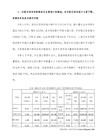
解 ,可认为进行5次独立试验,设Y为寿命大于1500小时的只数,Y~b(5,2/3), 至少有2只寿命大于1500小时的概率是
23.设顾客在某银行的窗口等待服务的时间X(以小时计算)服从指数分布,其概率密度为
某顾客在窗口等待服务,若超过10分钟,他就离开,他一个月要到银行5次,以Y表示一个月内他未等到服务而离开窗口的次数,写出Y的分布律,并求概率。
解 离开的概率为
=0.5167
24.设k在(0,5)上服从均匀分布,求方程
有实根的概率。
解 当 时,方程有实根,即或时,有实根,则有实根的概率为
当x[-1,1]时;
当x时,F(x)=1, 即
F(x)=
(2)利用分段积分可求F(x)
21.(1)由统计物理学知,分子运动速度的绝对值X服从马克思韦尔分布,其概率密度为
f(x)=
其中为常数,T为绝对温度,m是分子的质量,试确定常数A。
3/10
6/10
2. 一颗骰子抛掷两次,以X表示两次得到的点数之和,以X表示两次中得到的小的点数,
试分别求X的分布律。
解:两颗骰子相互独立,利用古典概型的算法可求出结果如下
(1)
2
3
4
5
6
7
8
9
10
111
解 (1)可视为古典概型问题,总挑法种数为,则成功一次的概率为
(2)设成功次数为X,则X~b(10,1/70)
因为能成功次的概率特别小所以可认为他确有区分的能力。
10.有一繁忙的汽车站,每天有大量汽车通过,设每辆汽车在一天的某时段内出事
p
(3) 参数为,=0.918
《概率论与数理统计》习题二答案解析
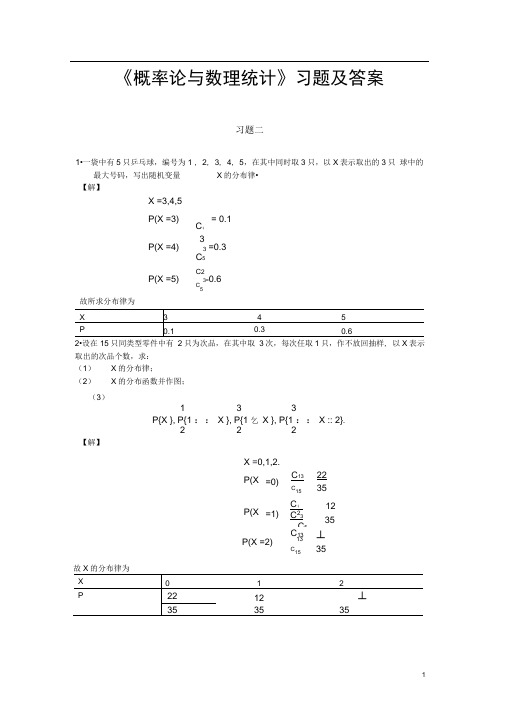
《概率论与数理统计》习题及答案习题二1•一袋中有5只乒乓球,编号为1 , 2, 3, 4, 5,在其中同时取3只,以X 表示取出的3只 球中的最大号码,写出随机变量 X 的分布律•【解】X =3,4,5 3P(X =4) 3 =0.3 C 5C 2P(X =5)3=0.6C52•设在15只同类型零件中有 2只为次品,在其中取 3次,每次任取1只,作不放回抽样, 以X 表示取出的次品个数,求: (1)X 的分布律; (2)X 的分布函数并作图;(3)1 3 3P{X }, P{1 :: X }, P{1 乞 X }, P{1 :: X :: 2}.2 2 2【解】X =0,1,2. C 13 P(X =2)13C15P(X =3) C ;= 0.1P(X =0) C 13C152235P(X =1)C ;C 23C 512 35丄 3534 34 门 0 2' 2' ' '35 3533 12P(1 _ X ) = P(X =1)P(1 :: X 厂2 2 3534 1P(1 ::: X ::2) = F(2) _ F(1)_ P(X =2) =1 0.35 35 3•射手向目标独立地进行了 3次射击,每次击中率为 0.8,求3次射击中击中目标的次数的 分布律及分布函数,并求 3次射击中至少击中 2次的概率. 【解】设X 表示击中目标的次数.则X=0,1,2,3.P(X = 0) = (0.2)3 = 0.0081 2P(X =1)70.8(0.2) =0.096 P(X 二 2) =C 3(O.8)2O.2 = 0.384P(X =3) =(0.8)3 =0.512故X 的分布律为 X 0 1 2 3 P0.0080.0960.3840.512分布函数” 0,X <00.008, 0 兰 xc1F(X )» 0.104, 1^x<20.488, 2 兰x<31,x^3P(X — 2) = P(X =2) P(X =3^ 0.8964.( 1)设随机变量X 的分布律为P{X=k}= a -,k!其中k=0, 1, 2,…,入〉0为常数,试确定常数 a.(2)设随机变量X 的分布律为P{ X=k}= a/N ,k=1, 2,…,N ,试确定常数a.0,x ::: 0 22 0 _ x :: 13534 1 _x :: 2351, x_2F(x)= (2)当 x<0 时,F (x ) =P (X w x ) =0当 0 w x<1 时, F (x ) 当 1 w x<2 时, F (x ) 22 =P (X w x ) =P(X=0)=- 35 34 =P (X w x ) =P(X=0)+P(X=1)=-35当x >2时,F 故X 的分布函数(x ) =P (X w x ) =1 1 1 22P(X =)★(;) ,2 2 353 3P(1 ::: X ) = F(:)-【解】(1)由分布律的性质知二:• k1 P(X 二k) =a aLe'k z0 k^o k!故 a = e_,(2)由分布律的性质知N Na1 =為P(X =k) akw k a N即 a = 1.5•甲、乙两人投篮,投中的概率分别为0.6,0.7,今各投3次,求:(1)两人投中次数相等的概率;(2)甲比乙投中次数多的概率.【解】分别令X、Y表示甲、乙投中次数,贝U X~b (3, 0.6) Y~b(3,0.7)(1) P(X 二Y)二P(X =0,Y =0) P(X =1,Y =1) P(X =2,Y =2)P(X =3,Y =3)3 3 1 2 1 2-(0.4) (0.3) C30.6(0.4) C30.7(0.3) +2 2 2 23 3C3(0.6) 0.4C3(0.7) 0.3 (0.6) (0.7)=0.32076(2) P(X Y) = P(X =1,Y =0) P(X =2,Y =0) P(X =3,Y =0)P(X =2,Y =1) P(X =3,Y =1) P(X =3,Y =2)1 2 3 2 2 3-C30.6(0.4) (0.3) C3(0.6) 0.4(0.3)3 3 2 2 1 2(0.6) (0.3) C3(0.6) 0.4C30.7(0.3)(0.6)3C;0.7(0.3)2(0.6)3C:(0.7)20.3=0.2436•设某机场每天有 200架飞机在此降落,任一飞机在某一时刻降落的概率设为 0.02,且设各飞机降落是相互独立的•试问该机场需配备多少条跑道,才能保证某一时刻飞机需立即降 落而没有空闲跑道的概率小于0.01(每条跑道只能允许一架飞机降落)?【解】设X 为某一时刻需立即降落的飞机数,则X~b(200,0.02),设机场需配备 N 条跑道,则有P(X ■ N) <0.01200即送 C k 00(O.O2)k (O.98)200上 £0.01k =N 1利用泊松近似-np = 200 0.02 = 4.血 e 44kP(X_N)0.01宀k!查表得N > 9.故机场至少应配备 9条跑道.7. 有一繁忙的汽车站,每天有大量汽车通过,设每辆车在一天的某时段出事故的概率为0.0001,在某天的该时段内有 1000辆汽车通过,问出事故的次数不小于 2的概率是多少(利 用泊松定理)?【解】设X 表示出事故的次数,则 X~b (1000, 0.0001)P(X _2) =1 -P(X =0) -P(X =1)0.1 0.1=1 —e - 0.1 e8.已知在五重贝努里试验中成功的次数 X 满足P{X=1}= P{X=2},求概率P{X=4}.【解】设在每次试验中成功的概率为p ,则14 2 2 3C 5p(1 - p) 9p (1 - p)9.设事件A 在每一次试验中发生的概率为 0.3,当A 发生不少于3次时,指示灯发出信号 (1)进行了 5次独立试验,试求指示灯发出信号的概率;(2)进行了 7次独立试验,试求指示灯发出信号的概率.【解】(1)设X 表示5次独立试验中 A 发生的次数,则 X~6 ( 5, 0.3)5P(X 工3)=送 c 5(0.3)k (0.7)5^ =0.16308k=3⑵ 令Y 表示7次独立试验中 A 发生的次数,则 Y 〜b ( 7,0.3)故 所以P(X =4)=C :(1)4拿10 2437 ■—k k 7 —kP(Y^3)=送C k(0.3)k(0.7)7=0.35293 k=310•某公安局在长度为t 的时间间隔内收到的紧急呼救的次数X 服从参数为(1/2) t 的泊松分63 1 13.进行某种试验,成功的概率为一,失败的概率为一.以X 表示试验首次成功所需试验的次44数,试写出X 的分布律,并计算 X 取偶数的概率. 【解】X =1,2,,k,|||1 k —1 p (x =k )y4P(X =2) P(X =4)P(X =2k)谱64 W …布,而与时间间隔起点无关(时间以小时计)(1) (2) 【解】(1) 求某一天中午12时至下午 求某一天中午12时至下午3P(X =0)3时没收到呼救的概率; 5时至少收到1次呼救的概率.5(2) P(X _1) =1 — P(X =0) =1 -k k2 _k11.设 P{X=k}= C 2P (1 - p) ,k=0,1,2mm4_mP{ Y=m}= C 4 p (1 - p)m=0,1,2,3,45分别为随机变量 X , Y 的概率分布,如果已知 P{X > 1}=,试求P{ Y > 1}.954I 解】因为P(X 牛,故P(X (9)P(X ::: 1) = P(X =0) =(1 - P)2故得24(仆)飞1 「3从而P(Y _1) =1 _P(Y =0) =1_(1_ p)465 0.80247810.001,试求在这 2000册书中 12•某教科书出版了 2000册,因装订等原因造成错误的概率为 恰有5册错误的概率. 【解】令X 为2000册书中错误的册数,则X~b(2000,0.001).利用泊松近似计算,■ - np 二 2000 0.001 二 2P(X =5)「255!-0.001811 514•有2500名同一年龄和同社会阶层的人参加了保险公司的人寿保险•在一年中每个人死亡的概率为0.002,每个参加保险的人在 1月1日须交12元保险费,而在死亡时家属可从 保险公司领取2000元赔偿金•求: (1) 保险公司亏本的概率; (2)保险公司获利分别不少于 10000元、20000元的概率.【解】以“年”为单位来考虑.(1) 在1月1日,保险公司总收入为 2500 X 12=30000元. 设1年中死亡人数为 X ,则X~b(2500,0.002),则所求概率为P(2000X • 30000) =P(X 15) P(X <14)由于n 很大,p 很小,入=np=5,故用泊松近似,有:4 e'5kP(X 15) = 10.000069k 竺k !⑵P(保险公司获利不少于 10000)= P(30000 -2000X _ 10000) =P(X < 10)20000) = P(30000 -2000X 一20000) = P(X 乞5)5 _5 k_ e 5 0.615961 k =0 k!即保险公司获利不少于 20000元的概率约为62% 15.已知随机变量 X 的密度函数为f(x)=Ae ,「8 <x<+ ,求:(1) A 值;(2) P{0<X<1}; (3) F(x).【解】(1)由 f (x)dx =1得1=Ae ^dx =2 Ae "dx =2A--:: 01 故 A . 2⑵ p(0 :X ::1)匚 0「dxs (1-e')⑶当x<0时,x1 1F (x )=[石 e x dx 匚 e x10k =0k!0.986305即保险公司获利不少于 10000元的概率在 98%以卜.P (保险公司获利不少于中任意小区间内的概率与这小区间长度成正比例,试求 X 的分布函数 【解】 由题意知X~ U [0,a ],密度函数为故当x<0时F (x ) =0 当 0< x w a 时 F(x)=当 x >0 时,F(x)= f^e X dx + 2 -::22 [-e~dx o 2F(x) =1 x 0 -e , x :::0 1」e 」x_0 2 16•设某种仪器内装有三只同样的电子管,电子管使用寿命 100, X —100,x x ::100. 在开始150小时内没有电子管损坏的概率; 在这段时间内有一只电子管损坏的概率; F ( x ). X 的密度函数为f(x)= 0,求: (1)(2) (3) 【解】 (1) 150 100 1 P(X < 150) r dx . ' )応 x 2 3 3 2 3 8 P 1 <P(X 150)]3 珂2)3 二石 3 2/⑵卩2 二 c ;3(2)2 ⑶当 x<100 时 F (x ) =0 x 当 x > 100 时 F(x) f (t)dtJ JO O 100 x 」(t )d t100f (t )dtx豁1t 2100x i 0,x _100x ::17•在区间]0, a ]上任意投掷一个质点,以 X 表示这质点的坐标,设这质点落在]1f (X )二 a' 0,0乞x 乞a其他xx;f (t )dt 「0x1 xf(眄0了蔦当 x>a 时,F (x ) =1即分布函数x F(x)二l a 1,18.设随机变量X 在[2 , 5]上服从均匀分布•现对 值大于3的概率. 【解】X~U [2,5],即Pf(x) = 3’【0,故所求概率为119•设顾客在某银行的窗口等待服务的时间X(以分钟计)服从指数分布E(-).某顾客在窗口55次,以Y 表示一个月内他未等 P{Y > 1}.> _xf(x)二孑5【0,该顾客未等到服务而离开的概率为Y~b(5,e 冷,即其分布律为P(Y =k) =c 5(e')k (1—e')5=k =0,1,2,3,4,5P(Y 一1)=1 -P(Y = 0) =1 -(1-e‘)5 =0.516720.某人乘汽车去火车站乘火车,有两条路可走.第一条路程较短但交通拥挤,所需时间X 服从N (40, 102);第二条路程较长,但阻塞少,所需时间 X 服从N (50, 42).(1)若动身时离火车开车只有 1小时,问应走哪条路能乘上火车的把握大些?(2) 又若离火车开车时间只有 45分钟,问应走哪条路赶上火车把握大些? 【解】(1)若走第一条路,X~N (40, 102),则「0, x :: 0P(X 3)=Qdx =3 3X 进行三次独立观测,求至少有两次的观测其他p=c 3(2)21 c 3(2)3 3 3 3 20 27等待服务,若超过10分钟他就离开•他一个月要到银行 到服务而离开窗口的次数,试写出 Y 的分布律,并求1【解】依题意知X ~ E(”),即其密度函数为x'5dx = -2ef x —4060—40 )斗 P(X :::60) = P(2) =0.97727V 1010 丿若走第二条路,X~N ( 50, 42),则X 「50 60「50 P(X ::: 60) = P(2.5) = 0.9938++V 441故走第二条路乘上火车的把握大些•(2)若 X~N (40, 102),则P(X :::45)=P X -4° :: 45一4° =::,(0.5)=0.6915I 10 10 丿若 X~N (50 , 42),则:::45 -5° = : :」(_1.25)4=1 -门(1.25) =0.1056故走第一条路乘上火车的把握大些.21•设 X~N (3,22),(1) 求 P{2<X<5}, P{4<X <10} , P{ | X |> 2}, P{X >3}; (2)确定 c 使 P{X > c}= P{X < c}.【解】(1) P(2:::X E5)=P 口」3 空口V 2 2 2 丿()2 () 2= 0.8413 -1 0.6915 =0.5328 P(—4 ::X —10) =P i.X 色一!^3V 222 丿 =O.9996P(| X | 2) = P(X 2) P(X :: -2)f X -3 2_3]丄 f X -3 _2_3; =P --------- > ------ (+P ---------- < ---------I 2 2丿 12 2丿 “—①i —丄①i —5匚①I 丄r —①i-l 2丿I 2丿12丿 12丿-0.6915 1 -0.9938 =0.6977P(X ::45) = P X -50—4X —3 3-3P(X 3) = P() J —::」(0) =0.5⑵c=322. 由某机器生产的螺栓长度(cm ) X~N (10.05,0.062),规定长度在10.05土 0.12内为合格品 求一螺栓为不合格品的概率.=1一门(2)亠处(一2)=2[1-::」(2)]二 0.045623. 一工厂生产的电子管寿命 X (小时)服从正态分布 N (160, (I),若要求P{120 v X < 200 =>0.8,允许i 最大不超过多少?(1) 求常数A , B ;(2) 求 P{X W 2} , P{X > 3}; (3)求分布密度f (x ).匹 F(x)=1 「A = 1【解】(1)由 … 得伽+F (x)巳监F(x)旧一1(2) P(X _2) = F(2) =1 -e ,'P(X 3) =1 _F(3) =1 _(1_eA )25.设随机变量X 的概率密度为・x,f (x )=」2 - x,0,求X 的分布函数F (x ),并画出f (x )及F (x )f (x^ F (x)0,x 一0 x :: 0 【解】P(|X -10.05| 0.12) =PX —10.05 0.060.12>0.06』【解】P(120::"200)=P 1^1坐3 乞叱型 故24.设随机变量X 分布函数为40-31.251.29F (x )A Be*,0,x 一0,x 0.0 空 x :: 1,仁 x :: 2,【解】当x<0时F (x ) =0xtdt当 1W x<2 时 F(x)二 f (t)dt1-0tdt (2-t)dt1 2x22 2 2x2x -1x 当 x >2 时 F (x) f (t)dt = 126•设随机变量X 的密度函数为(1) f(x)=ae_ |x|,入 >0;f(x)二 2c 'X2e当 x W 0 时 F (x) = J 』(x)dx =访e% = 2,当 0W x<1 时 F(x)=xJ (t)仁x.f(t)dtF(x)二x 22x 2x -1,21,x :: 0x _2⑵f(x)= 试确定常数 【解】(1)由bx, 12,x 0,0 ■ x :: 1, 1 < x < 2,其他•a,b ,并求其分布函数 F ( x )."f (x)dx =1知 1J JO O2ax 2 3即密度函数为当 x>0 时 F (x) =(x)dx =J :eMdx 壮专e —x dx故其分布函数x _01 f (x)2, |x 0,当 x < 0 时 F (x ) =0当 0<x<1 时 F(x) f (x)dx f(x)dx 亠 I f (x)dx当 1 w x<2 时 F(x)二 J-f (x)d ^j-Qdx当 x > 2 时 F (x ) =1 故其分布函数为广0, 2xJF(x)二 23_12 x1,27•求标准正态分布的上:-分位点,(1) : =0.01,求 z ; (2) : =0.003,求 z-., z-./2. 【解】(1) P(X Z.H0.01即 :G( z :.)=0.09故z —2.33x=0xdxx 21 八-3 - 2F(x)1丄」 2(2)由 1 = f°°f(x)dx = f1bxdx — dxx得即X 的密度函数为b=1x, 0 : x :: 1其他xdx1严x-0 0 ■ x ■■■ 1 1 < x ::即心(zj =0.012a(2)由 P(X .乙)=0.003得 1 (zj =0.003即 :•:」(乙)=0.997 查表得乙.=2.75由 P(X z ./2) =0.0015 得1-:」(Z-./2)=0.0015即 ■->( Z") =0.9985查表得z :./2 =2.96求Y=X 的分布律.【解】Y 可取的值为0, 1, 4, 9P(Y =0) =P(X =0)」5P(Y =1) = P(X =「1) P(X =1)=1 -~6 15301 p (Y =4) =P(X - -2): 5 11 P(Y =9) = P(X =3)=3029•设 P{X=k}=( 1): k=1,2,…,令Y 「1,当X 取偶数时 1-1,当X 取奇数时.求随机变量X 的函数Y 的分布律.【解】P(Y =1) =P(X =2) P(X =4) "I P(X =2k)川=G )2 G )4 川(1)2k 川2 2 2 1 1 1 =()/(1 厂4 4 3P(Y =—1) = 1 — P(Y =1) = 2 30•设 X~N (0, 1).(1) 求Y=e X 的概率密度; (2) 求Y=2X 2+1的概率密度; (3)求Y= | X |的概率密度•【解】(1)当 y w 0 时,F Y (y)二 P(Y 曲)=0x当 y>0 时,F Y (y) =P(Y 空 y) =P(e < y^P(X < ln y)In y二:i- fX (x)dx(2) P(Y =2X 2 1 _1) = 1当 y w 1 时 F Y (y) =P (丫 乞 y) =02当 y>1 时 F Y (y) =P (丫 乞 y) =P(2X 1 乞 y)(y J)/2「一 R f X (x)dx故 f 丫(y)=f F 丫(y)三民:f x (厅]+f x 「F]]⑶ P(Y-0)=1当 y w 0 时 F Y (y)二 P (Y — y) =0dF y (y)11 1 j n 2y /2 JEW ,y 0= PX 2 哼二P< X <4y 4)/4e , y 1当 y>0 时 F Y (y) = P(| X 国 y)二 P( —y 乞 X 乞 y)y二 y f x (x)dx故 f Y (y):F Y (y )二 f x (y) f x (-y)dy31. 设随机变量X~U (0,1),试求:(1) Y=e x 的分布函数及密度函数; (2)Z= -21 nX 的分布函数及密度函数【解】(1) P(0 ::X :::1) =1故 p( 1 ::: Y 二 e ::: e) 1 当 y _1 时 F Y (y) =P(Y 乞 y) =0当 1<y<e 时 FY (y) =P(e X 乞 y) =P(X On y)In y「0 dx=lnyX当 y 》e 时 F Y (y)二 P(e < y) = 1 即分布函数J, y^e故Y 的密度函数为口 f Y (y)二 y,0,(2) 由 P ( 0<X<1) =1 知P(Z 0) =1当 z w 0 时,F z (z) =P(Z Ez) =0当 z>0 时,F Z (z)二 P(Z 乞 z)二 P(—2ln X ^z)=P(ln X _ -自二 P(X _e 亠2)y 0,F /(y)=七n y,y 乞1 1 ::1 ::y e故Z的密度函数为32. 设随机变量X的密度函数为2xf(x)= n io,0 ::xn其他.试求Y=sinX的密度函数.【解】P(0 Y:::1) =1当y w o 时,F Y(y)二P(Y ^y) =0当0<y<1 时,F Y(y)二P(Y 空y)二P(sin x 乞y)二P(0 :: X M arcsin y) P( n- arcsin y 玄X ::narcsiny 2x n2x2dx 2dx0 n -arcsin y 彳=4( arcsiny)2 1- arcsin®2n n2 .arcs in yn当y》1 时,F Y(y)=1故Y的密度函数为33. 设随机变量X的分布函数如下:z/2即分布函数I z/2 dx = 1 - eu a -----z<0-z/21-ez 0zMX』2,X 』2,18试填上(1),(2),(3)项.F(x) = 1 x‘(2)X-(3) •19【解】由lim F(x) =1知②填1。
- 1、下载文档前请自行甄别文档内容的完整性,平台不提供额外的编辑、内容补充、找答案等附加服务。
- 2、"仅部分预览"的文档,不可在线预览部分如存在完整性等问题,可反馈申请退款(可完整预览的文档不适用该条件!)。
- 3、如文档侵犯您的权益,请联系客服反馈,我们会尽快为您处理(人工客服工作时间:9:00-18:30)。
Permutations and Combinations
Definition An ordered subset is called a permutation. The number of permutations of size k that can be formed from the n individuals or objects in a group will be denoted by Pk,n. An unordered subset is called a combination.
Finally, for each way of selecting a chair and vice-chair, there are n3 = 5 ways of choosing the secretary. This gives P 3,7 = (7)(6)(5) = 210 as the number of permutations of size 3 that can be formed from 7 distinct individuals. The expression for P3,7 can be rewritten with the aid of factorial notation. Recall that 7! (read “7 factorial”) is compact notation for the descending product of integers (7)(6)(5)(4)(3)(2)(1).
11
Permutations and Combinations
Proposition
12
Example 21
There are ten teaching assistants available for grading papers in a calculus course at a large university. The first exam consists of four questions, and the professor wishes to select a different assistant to grade each question (only one assistant per question). In how many ways can the assistants be chosen for grading? Here n = group size = 10 and k = subset size = 4.
13
Example 21
The number of permutations is P4,10 10(9)(8)(7) = 5040
cont’d
That is, the professor could give 5040 different four-question exams without using the same assignment of graders to questions, by which time all the teaching assistants would hopefully have finished their degree programs!
Notice that and since there is only one way to choose a set of (all) n elements or of no elements, and since there are n subsets of size 1.
15
Supplementary Example 1
5
Permutations and Combinations
Or if a university bookstore sells ten different laptop computers but has room to display only three of them, in how many ways can the three be chosen? An answer to the general question just posed requires that we distinguish between two cases. In some situations, such as the baseball scenario, the order of selection is important.
Often, though, order is not important and one is interested only in which individuals or objects are selected, as would be the case in the laptop display scenario.
How many ways are there to select a subset of size k from the group? For example, if a Little League team has 15 players on its roster, how many ways are there to select 9 players to form a starting lineup?
For each way of selecting the chair, there are n2 = 6 ways to select the vice-chair, and hence 7 6 = 42 (chair, vice-chair) pairs.
9
Permutations and Combinations
7
Permutations and Combinations
The number of permutations can be determined by using counting rule for k-tuples. Suppose, for example, that a college of engineering has seven departments, which we denote by a, b, c, d, e, f, and g.
How many ways are there to select the three officers? That is, how many permutations of size 3 can be formed from the 7 representatives?
8
Permutations and Combinations
Letting N denote the number of outcomes in a sample space and N(A) represent the number of outcomes contained in an event A,
(2.1)
3
Permutations and Combinations
10
Permutations and Combinations
More generally, for any positive integer m, m! = m(m – 1)(m – 2) ····(2)(1). This gives 1! = 1, and we also define 0! = 1. Then
To answer this question, think of forming a triple (3-tuple) in which the first element is the chair, the second is the vice-chair, and the third is the secretary. One such triple is (a, g, b), another is (b, g, a), and yet another is (d, f, b). Now the chair can be selected in any of n1 = 7 ways.
4
Permutations and Combinations
Consider a group of n distinct individuals or objects (“distinct” means that there is some characteristic that differentiates any particular individual or object from any other).
There are 10 products containing 4 of the first type and 6 of the second type, respectively, choose in two methods and find the probability of the following events: A = {all 3 products chosen randomly from 10 belong to the second type}; B = {among 3 products chosen randomly from 10,there are 2 of the first type and 1 of the second type}. Methods: (1) Choosing one each time without replacement, called a sampling without replacement. (2) Choosing one each time with replacement , called a sampling with replacement.
2
Probability
